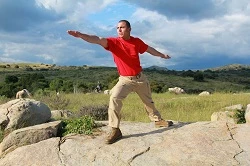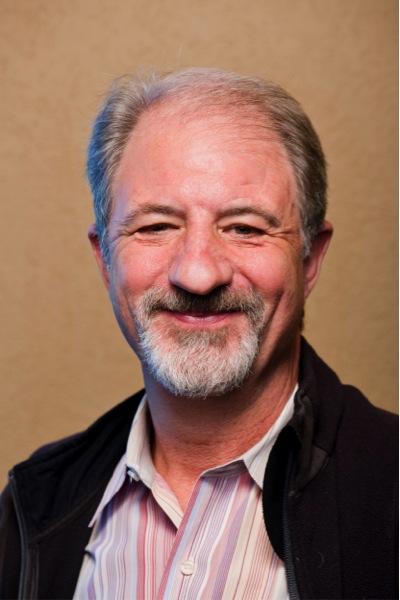Trauma-Sensitive Yoga Therapy in Practice

This is an interview with David Emerson, who was a social worker for 10 years before going to graduate school to become a therapist — a talk-based psychotherapist. Well, he just didn’t click with that modality. He became a certified yoga teacher in 1999. After connecting with Bessel van der Kolk in 2001-02, they started the Trauma Center Yoga Program together soon thereafter. With Elizabeth Hopper, David is co-author of Overcoming Trauma Through Yoga: Reclaiming Your Body.
Rob: What originally motivated you to do this work, and what continues to motivate you? How, if at all, has that motivation changed over time?
The primary motivation was the fact that our country was ramping up for two wars, and there is a wet shelter (a homeless shelter where people are not turned away if they are actively using drugs and alcohol) around the corner from my house filled mostly with Vietnam vets. I knew we’d be seeing the younger vets in there soon enough. As we started the Trauma Center Yoga Program and as things evolved, we started working mostly with survivors of chronic, complex, intra-familial abuse and neglect, and this is where the potential benefits of Trauma-Sensitive Yoga really started to reveal themselves. Now I work mostly with teens who have had a great deal of trauma exposure. I also have a veterans group and we continue to meet sporadically after nine years.
Is there a standout moment from your work at the Trauma Center?
When Senator Kennedy mentioned our yoga program during his comments for the Trauma Center’s 25th anniversary I felt like yoga had arrived as a serious, viable treatment. One of two other incredibly meaningful moments was our team receiving the first grant ever given by the National Institutes of Health to study yoga and trauma; the other was completing the first — and to date only — randomized controlled PTSD trial using yoga as the therapeutic intervention. Finally, any day on which someone I am working with notices a body feeling and makes a choice about what to do with it, is a standout day.
What did you know about the population you are working with before you began teaching? What were some of the assumptions you had about this population, and how have those assumptions changed?
I knew trauma was complex, but I didn’t really understand how complex. I have been very lucky to have had several adult students over the years who have been willing to articulate for me what it’s like to have a body after suffering through tremendous trauma. I have learned everything I know from them.
What are two distinct ways that your teaching style differs from the way you might teach in a studio, and what are the reasons for these differences?
We do no physical assists and the teacher does not move around the room. To fully explain these teaching points would take up too much space here but they are the result of our understanding of the impacts of trauma that include: 1. disscociation (when people “check out” or have fragmented experiences that from time to time do not include you); 2. the internal interpretation of external stimuli (like touch); and 3. the feeling of safety in relationships.
What has been the greatest challenge in your teaching experience, and what tools have you developed for addressing that challenge?
The biggest challenge for me has been something that is very specific to the kind of chronic, interpersonal trauma that we are working with. Because the trauma took place within the context of a relationship, and the student and I are now entering into a relationship (even more pointed, a relationship with power dynamics, teacher-student), there are times when I have been the source of a trigger for someone. It could be the way I dress, the way I move, a facial expression or a tone of voice — anything. Sometimes when this happens people become very angry with you, or scared of you, and this has been the most difficult thing for me to experience. The best way we have found as a team to deal with these experiences is to talk with each other. We are a team of yoga teachers and clinicians and we all support each other.
What advice would you give to anyone who is going to teach in the populations you work with?
Please don’t go it alone. Get involved with some kind of treatment center where you can interact with therapists, and they with you. If you do yoga with traumatized people it is automatically a clinical issue. Please respect that, and do your due diligence in terms of learning about trauma and its impact on the entire organism.
What are some of your ideas about or hopes for the future of “service yoga” in America in the next decade?
I would like to see more science, more data, and more randomized controlled studies. In my opinion we owe it to our clients/students and to our future funders (tax payers and private citizens) to prove what works, and to recognize what doesn’t. We need to enter into the empirical domain, as difficult and as challenging as that is for yoga teachers like me!
How has this work changed your definition of service? Your definition of yoga? Your practice?
First, in terms of my definition of yoga, there have been very real changes as a result of my work with traumatized people. For one thing, the whole process has become much simpler. I feel like I used to put a lot more effort into practicing yoga than I do now. In my personal practice I find that I am less inclined to interpret my body experience and more comfortable just trusting the experience itself. I find that I make less effort to do yoga for someone else, some external approval, and am more interested in practicing yoga for the pure joy of reminding myself that I am here, that I have a body, that I exist.
On the question of service my response is that service, to me, is not a side project. It is a fully-integrated, professional endeavor. Yoga teachers should be paid a reasonable wage if they are offering trauma survivors, for example, a high quality treatment with proven outcomes. People are suffering tremendously, and they need others to devote themselves to their care and unless one is independently wealthy (and more power to you if you are!), one needs to make a living. Service and making a living do not have to be mutually exclusive.
What other organizations do you admire?
There are many, but 3 that I am particularly fond of are:
thereandback-again.org
mandalahouse.org
greentreeyoga.org
Originally published on Huffington Post and Give Back Yoga Foundation
 Rob Schware is the Executive Director of the Give Back Yoga Foundation, President of the Yoga Service Council, and Seva Advisor to Hanuman Festival. He has been married to Alice Trembour for 28 years, which, like yoga, is in and of itself a regular commitment to a practice. They have three children.
Rob Schware is the Executive Director of the Give Back Yoga Foundation, President of the Yoga Service Council, and Seva Advisor to Hanuman Festival. He has been married to Alice Trembour for 28 years, which, like yoga, is in and of itself a regular commitment to a practice. They have three children.
You can follow The Give Back Yoga Foundation for news, updates, and fun on Twitter at @givebackyoga. www.givebackyoga.org



